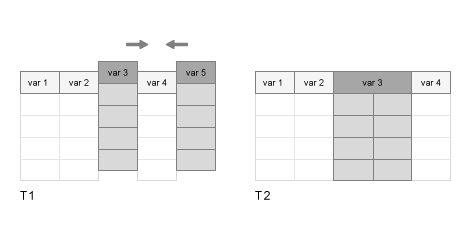mergevars
Combine table or timetable variables into multicolumn variable
Description
T2 = mergevars(
combines the table variables specified by T1,vars)vars to create one
multicolumn variable in T2. All other variables from
T1 are unaltered. You can specify variables by name, by
position, or using logical indices.
For example, if T1 has variables named var3
and var5, then you can combine them into a variable that has two
columns by using T2 = mergevars(T1,["var3","var5"]).

By default, the name of the merged variable in T2 takes the
form Var, where
NNT2, then its name is Var3.
To split multicolumn variables, use the splitvars function.
T2 = mergevars(
specifies options using one or more name-value arguments in addition to the input
arguments in the previous syntax. For example, to specify a name for the merged
variable, set T1,vars,Name,Value)NewVariableName to the name that you
specify.
Examples
Input Arguments
Name-Value Arguments
Extended Capabilities
Version History
Introduced in R2018a